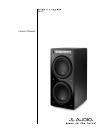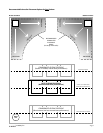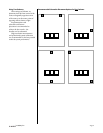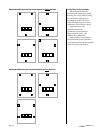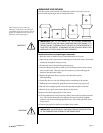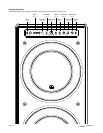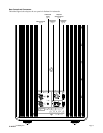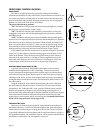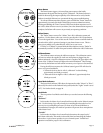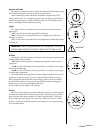
Page 6 | Fathom f212
PLACING YOUR FATHOM IN YOUR LISTENING ROOM:
Your listening room or theater is an integral part of your sound reproduction
system. e physical dimensions of the room and its furnishings, materials,
doors and windows play an important role in de ning how your system sounds.
When you place a sound source in an enclosed rectangular space, “standing
waves” are created, resulting from the relationship between the sound’s
wavelength and your room’s dimensions. In other words, standing waves result
from sound energy that is trapped in the room as it bounces back and forth
between opposing walls. Standing waves in the room create acoustic peaks and
dips where the sound is either louder or so er, based solely on your physical
position in the room. Energy also “builds up” at the room’s boundaries, creating
exaggerated bass response at certain frequencies. ese fundamental room
resonances are called room “modes.”
e moral of this mode story is to try and avoid seating positions in standing
wave peak or dip regions. It is highly recommended that you place your listening
chairs in areas where modal peaks and dips are moderate and do not reinforce
one another. e two most obvious areas to avoid are those near the exact center
of the room and those close to any of the room’s walls.
Just as your listening seat can be in a peak or dip region, so can your
subwoofer. When placed in a room corner, a subwoofer maximally excites the
room’s mode structure, creating the strongest output with the fewest dips. When
the subwoofer is pulled away from a corner or wall, the room modes are excited
less, which can alter the sound at your listening seat.
Be sure to experiment with both your listening seat position and subwoofer
position to nd the best solution. Careful experimentation usually leads to a
superior sounding system. Use our setup suggestions (illustrated on the opposing
page and the following pages) to get you started.
If you cannot avoid placing your sofa against the back wall or your
subwoofer in a less than optimal position, all is not lost. Your Fathom’s
Automatic Room Optimization (A.R.O.) System can dramatically improve
these less-than-ideal situations.
We recommend that you begin by placing your Fathom in the front of the
room, near the front le or right speaker. Placing it directly in the front corner
of the room will produce the maximum number of peaks and the minimum
number of dips in the bass response. is can be advantageous because the
Fathom’s A.R.O. system can correct the primary peak very e ectively, whereas
dips in response cannot be corrected via equalization. Dips in response can only
be minimized via careful subwoofer and listener placement.
Placing the Fathom near solid walls will reinforce bass response and pulling
it away from solid walls will decrease bass. Increasing the distance between the
subwoofer and the walls may help to smooth upper bass response in some rooms.
We recommend that you avoid placing the Fathom near windows to prevent
rattling and sound transmission to the outside world.
If you are planning to install your Fathom
inside a cabinet, please refer to the
guidelines on page 8.



